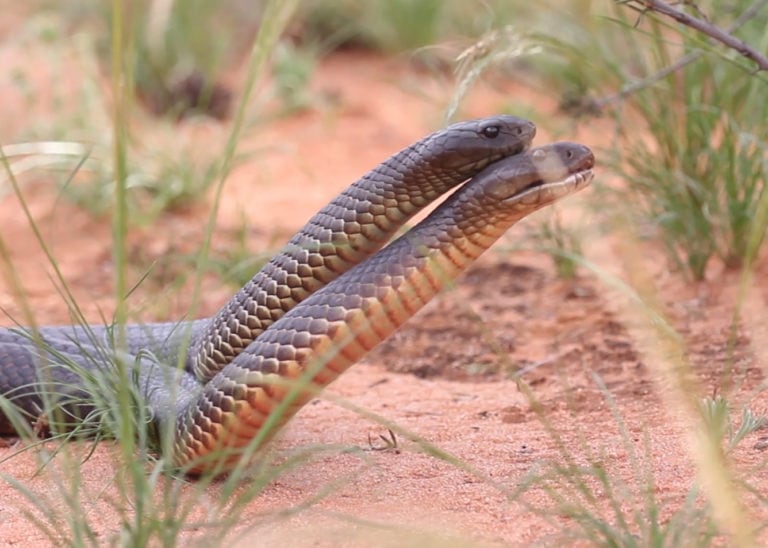Rare footage of fighting Mulga snakes recorded at Scotia Wildlife Sanctuary

It’s a sight few are lucky enough to ever witness: Australia’s largest terrestrial venomous snake in combat.
But staff and volunteers at AWC’s Scotia Wildlife Sanctuary were recently treated to front row seats.
AWC ecologist Tali Moyle managed to capture brilliant footage of the exciting fight – a video which has since racked up more than 15 million views on the AWC Facebook page.
Tali was leading a numbat survey at the sanctuary (located in outback NSW, and home to one of Australia’s largest feral predator-free areas) when the rarely-seen activity was spotted:
“We all jumped out the car with our cameras as quickly as we could. I had two volunteers with me, who are also really into reptiles, so we all just watched and were amazed by what we were seeing.”
The two male snakes can be seen fiercely wrestling with each other, repeatedly pushing their opponent’s head to the ground in a bid for dominance. The stakes are high in such a scenario: the loser will have to leave the area, and the winner will have mating rights to local females.
But deciding a winner is not a quick process, as Tali explains:
“We watched them for at least an hour, and they continued after we left them.
We had to wait for them to get off the road to drive past. They didn’t even flinch when we drove really close next to them, they were so pre-occupied.”

Fighting… or mating?
AWC ecologists confirm this is definitely combat footage, but the video has nevertheless attracted thousands of comments on social media arguing that this is, in fact, mating.
Mating and fighting can look very similar, but there are several important differences:
Fighting behaviour involves wrestling for dominance, with males pushing each other’s heads down, lots of movement, hissing, and sometimes flattened necks.
Combat has been documented a few times in Mulga Snakes, including from Lloyd, R and Trembath, D. (2010) on our Mornington Sanctuary, WA. They describe it as snakes trying to push each other’s head down in a wrestling match, entering entwined coils (corkscrews), and often raising their fore body off the ground in an attempt to gain the upper position (Lloyd, R and Trembath, D. 2010). Similar behaviour has been documented with Little Whip Snakes (Turner, G. 1992).
Mating behaviour involves slower movements, chin rubbing, smooth massaging movements from male to female, and the male’s tail making manipulative movements in attempts to copulate. Males can be over/on top of female (mounting) or to the side, with vents making contact and more of a wiggle or jerking movement (Turner, G. 1992).

Mulga Snakes
Scientific name: Pseudechis australis
Common Names: Mulga Snake, King Brown Snake
Highly venomous: Medical attention is required if bitten.
A member of the Elapidae family, the Mulga Snake is the largest terrestrial venomous snake in Australia, reaching lengths up to 2.5 m (Wilson, W and Swan, G. 2017).
While Mulga Snakes are sometimes called King Brown Snakes, they are actually in the Black Snake family and are more closely related to Red Bellied Black Snakes rather than Eastern or Western Brown Snakes.
Like many of Australia’s snakes, they can have slight colour variations, but are typically copper or reddish-brown to dark-olive-brown, with a creamy/salmon coloured underbelly (Cogger, H. 2014).
Mulga Snakes are generally widespread and can be commonly found throughout most of Australia, with the exception of Victoria, Tasmania and along Australia’s eastern and southern coastlines. They occur in a wide variety of habitats across their range, from the wet tropics in Northern Australia to the central deserts (Cogger, H. 2014).

Mulga snakes have a varied diet feeding on mammals, birds, bird eggs, frogs, reptiles (including other snakes) (Cogger, H. 2014), reptile eggs and may occasionally eat invertebrates and carrion.
Birds of prey are the Mulga Snakes’ main predator when they are smaller, however once fully grown (at over 2 metres) they have very few predators.
Mating will typically occur in early spring with a gestation period of 39 -42 days, before eggs are deposited, with clutch sizes ranging from between 4 – 19 eggs. Depending on the temperature, eggs will incubate for between 70 – 100 days before the hatchlings break free of the soft-shelled eggs (Aust Museum).
As Tali summaries, “Snakes are awesome animals. If you give them space and watch their behaviour they are really interesting – and not as scary as people think”.

References
- https://australian.museum/learn/animals/reptiles/mulga-snake/#:~:text=Mulga%20Snakes%20are%20apparently%20immune,bitten%20by%20their%20own%20species.
- Cogger, H. (2014) “Reptiles and Amphibians of Australia”, Reed New Holland.
- Lloyd, R & Trembath, D. (2010) Male combat in the Mulga snakes Pseudechis australis (Serpentes: Elapidade): A series of observations from Northern Australia. Herpetofauna 40 (1) 2010.
- Turner, G. (1992) Courtship behaviour and male combat in the little Whip Snake, Rhinoplocephalus flagellum (Elapidae). Herpetofauna 22 (1) 1992.
- Wilson, S. and Swan, G. (2017) “A Complete Guide to Reptiles of Australia”, Reed New Holland.
This article is republished courtesy of the Australian Wildlife Conservancy.

